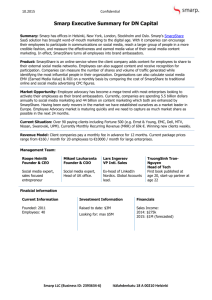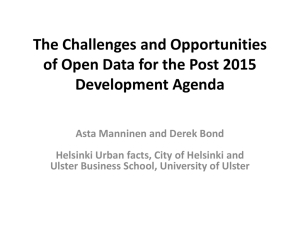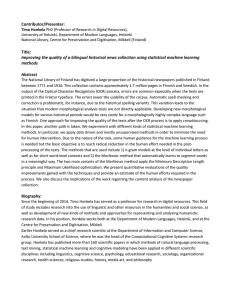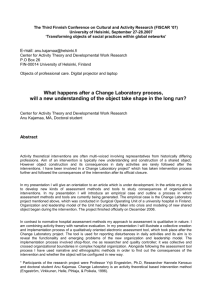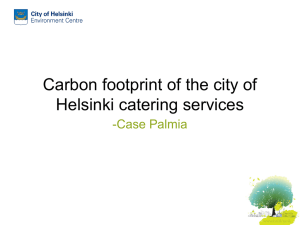City of Helsinki Culinary Culture Strategy
advertisement
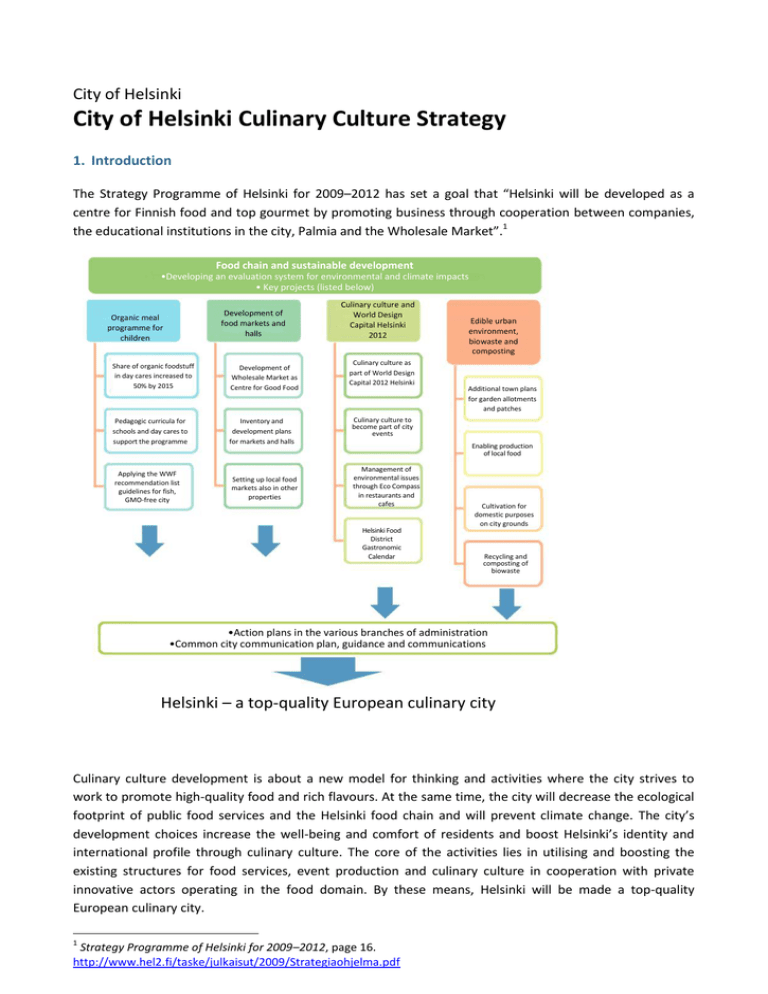
City of Helsinki City of Helsinki Culinary Culture Strategy 1. Introduction The Strategy Programme of Helsinki for 2009–2012 has set a goal that “Helsinki will be developed as a centre for Finnish food and top gourmet by promoting business through cooperation between companies, the educational institutions in the city, Palmia and the Wholesale Market”.1 Food chain and sustainable development •Developing an evaluation system for environmental and climate impacts • Key projects (listed below) Development of food markets and halls Organic meal programme for children Share of organic foodstuff in day cares increased to 50% by 2015 Development of Wholesale Market as Centre for Good Food Pedagogic curricula for schools and day cares to support the programme Inventory and development plans for markets and halls Applying the WWF recommendation list guidelines for fish, GMO-free city Setting up local food markets also in other properties Culinary culture and World Design Capital Helsinki 2012 Culinary culture as part of World Design Capital 2012 Helsinki Edible urban environment, biowaste and composting Additional town plans for garden allotments and patches Culinary culture to become part of city events Enabling production of local food Management of environmental issues through Eco Compass in restaurants and cafes Helsinki Food District Gastronomic Calendar Cultivation for domestic purposes on city grounds Recycling and composting of biowaste •Action plans in the various branches of administration •Common city communication plan, guidance and communications Helsinki – a top-quality European culinary city Culinary culture development is about a new model for thinking and activities where the city strives to work to promote high-quality food and rich flavours. At the same time, the city will decrease the ecological footprint of public food services and the Helsinki food chain and will prevent climate change. The city’s development choices increase the well-being and comfort of residents and boost Helsinki’s identity and international profile through culinary culture. The core of the activities lies in utilising and boosting the existing structures for food services, event production and culinary culture in cooperation with private innovative actors operating in the food domain. By these means, Helsinki will be made a top-quality European culinary city. 1 Strategy Programme of Helsinki for 2009–2012, page 16. http://www.hel2.fi/taske/julkaisut/2009/Strategiaohjelma.pdf 2 Key individual projects in the City of Helsinki culinary culture development programme include the organic meal programme for children, development of the Wholesale Market, integration of culinary culture development into the World Design Capital Helsinki 2012 project and city events as well as augmentation of small-scale farming in or near residential areas. The set goals are in line with the Finnish Culinary Culture Development Programme (2008–2011) launched by the Finnish government.2 2. Food chain and sustainable development The European Union is currently committed to reducing greenhouse gas emissions that contribute to global warming by 20–30% from the 1990 levels by 2020. By 2050, greenhouse gas emissions must be reduced significantly more. Finland, among others, has already committed to reducing emissions by 80% by 2050. In addition to future European directives, national legislation will probably be used to control the footprint caused by coal, water and the industry. Furthermore, Helsinki’s participation in the Covenant of Mayors agreement, which covers 1,300 cities, obliges the city to increase energy efficiency and decrease its carbon footprint by other means more than required by the European Commission alone. Controlling climate change is also among the goals in the strategy programme approved by the Helsinki City Council. The food chain has an important role in fighting climate change as the share of greenhouse gases caused by the food chain is generally estimated to be 10–30%, which is higher than the total emissions coming from traffic. Organic food, meaning natural farming and production, is a production method that causes less strain on the environment and respects nature’s own systems and cycles. Organic production comprises plant and animal production as well as food products that can be harvested from nature. In organic production, plantations are run by following a long-term cultivation cycle as well as by utilising biotic fertilisers. The use of chemical control substances and artificial fertilisers is forbidden. Organic production is a production method controlled by the authorities and regulated by the EU Organic Regulation. As Finland’s largest employer and largest provider of mass meals, a significant actor for public procurements and the developer of the operational environment for Helsinki residents and businesses, Helsinki has the possibility to influence food production methods and the entire food chain. The City of Helsinki can act as a forerunner through Palmia food services and as a catalyst for its residents, employees and the hotel, restaurant and catering (HoReCa) businesses in Helsinki. In addition, Helsinki has international political influence. Actions 2 Creating an evaluation of the environmental and climate impacts of the City of Helsinki food chain and a climate counter for food services. Together, these form the factual basis for implementing the city’s climate policy for food services (City of Helsinki Environment Centre). The goal of the Finnish Culinary Culture Development Programme (2008–2011) is to increase the appreciation of food. Target groups include actors that make decisions on food and Finnish consumers, especially the young and the children as well as families with children. Programme actions are focused on increasing the appreciation of food and its producers, promoting local and organic food, developing quality, providing nutritional guidance and internationalising the Finnish food industry. See www.sre.fi. 3 Gradually increasing the use of organic and local food for the city’s own food services. The organic meal programme for children will be launched in the initial phase (see section 3). Promoting local and organic food markets by improving their marketplaces, such as the Wholesale Market, other markets and food halls (see section 4). Promoting management of environmental issues for restaurants, food services and hotels with the Eco Compass system (see section 5). Indicators The strain on the environment and climate caused by the Palmia food chain decreases (evaluation to be carried out by the Environment Centre). 3. Organic meal programme for children Actions Launching an organic food programme for children where the share of organic foodstuff is increased to 50% in Helsinki day cares by 2015 as well as gradually increasing the use of organic food in comprehensive schools and other educational institutions. The actions will be implemented as permitted by the budget and the financial plan. (Responsible office: Palmia, in cooperation with the Social Department, Education Department and Procurement Centre.) Connecting the change to the pedagogic curricula for schools and day cares (Education Department, Social Department). The city also commits to the WWF recommendation list guidelines for fish and declares itself a GMO-free zone (Palmia). Indicators Percentage share of the use of organic food. In day cares, the 50% share will be met by 2015. In other food production, the use of organic food will be increased gradually. 4. Development of food markets and halls Actions Developing the Wholesale Market as the “Centre for Good Food” (Wholesale Market). This will include the Food Centre knowledge unit, which features an information centre for good food and information about the history of food, health effects, the importance of communality and experiences. The Centre for Good Food will also feature learning facilities that can be used for cooking, teaching cultivation and experiences. In addition, the Centre for Good Food will have facilities for restaurants and exhibitions, and it will combine ethnic, multicultural food, design and traditions to learning together and experiences in accordance with fresh season periods. If possible, the Wholesale Market teaching kitchen will be built so that the Finnish National Cook Team can use it for practices. 4 Making an inventory of and developing the markets and halls controlled by the City of Helsinki and profiling different halls and markets in order to increase their unique attractiveness. Social media will be used to generate ideas for halls and markets (Wholesale Market, Construction Department). Forming a shared view for all departments on the prerequisites for launching local food markets operating in premises other than those owned by the city (Environment Centre and Building Inspection Office). Indicators Development of retailers and overall sales as well as visitor numbers for halls, the Wholesale Market and other markets and halls. 5. Culinary culture and World Design Capital Helsinki 2012 Actions Making culinary culture part of the World Design Capital Helsinki 2012 project and events and creating WOW-experiences through it. New prerequisites related to culinary culture will be created for different events in the city centre, including Senate Square, the Wholesale Market, Lasipalatsi Square and Narinkka Square (Cultural Centre and Event Unit). Promoting tighter integration of culinary culture into city events where this is feasible (Cultural Centre and Event Unit). Where applicable, including culinary culture in the activities of the Cultural Centre and multicultural centres (Cultural Centre). Boosting the role of culinary culture as part of the city's international image and tourism marketing and communications (Tourism and Congress Office, Communications). Applying the lighter Eco Compass environment system more extensively to restaurants, food services and hotels (Environment Centre). Creating the Food District Helsinki map for restaurants, shops and actors, the Helsinki Menu and the ethnic shops on Hämeenkatu as a free printed map and a printable online map (cf. Design District Helsinki) (Tourism and Congress Office, Communications). Creating the Gastronomic Calendar, which highlights using seasonal products according to different seasonal festivities. The Gastronomic Calendar also highlights foodstuff, restaurants, people and the overall culinary culture through a seasonal cycle. The calendar will cover the entire year through stories. Organising the annual meeting for the Délice network of good food cities in the world in Helsinki in 2012. Indicators Presence and role of culinary culture in different events. 6. Edible urban environment, biowaste and composting Actions 5 Creating town plans for new garden allotments and patches as well as enabling the establishment of kitchen gardens also in the courtyards of residential buildings, including blocks of flats, in both new and existing residential areas (City Planning Department). Producing local food as close to residential centres as possible as a source of livelihood and enabling direct sales in residential centres. Boosting communications and guidance for the recycling and composting of biowaste (Helsinki Region Environmental Services, Waste Management Unit, Environment Centre). Highlighting locations in different districts where cultivation for home use is allowed (Environment Centre). Indicators Amount of small-scale cultivation of food in courtyards, patches and garden allotments. Efficiency of biowaste recycling.
